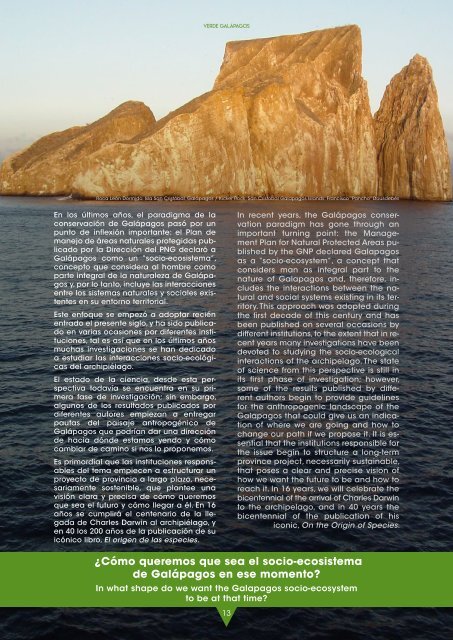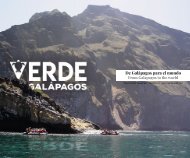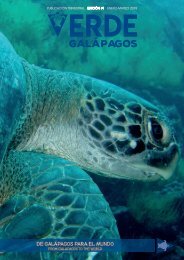Verde Galápagos #2
Te invitamos a leer nuestra segunda edición de la revista digital Verde Galápagos.
Te invitamos a leer nuestra segunda edición de la revista digital Verde Galápagos.
Create successful ePaper yourself
Turn your PDF publications into a flip-book with our unique Google optimized e-Paper software.
verdE galápagos<br />
Roca León Dormido, Isla San Cristóbal, <strong>Galápagos</strong> / Kicker Rock, San Cristobal Galapagos Islands: Francisco “Pancho” Dousdebés<br />
En los últimos años, el paradigma de la<br />
conservación de <strong>Galápagos</strong> pasó por un<br />
punto de inflexión importante: el Plan de<br />
manejo de áreas naturales protegidas publicado<br />
por la Dirección del PNG declaró a<br />
<strong>Galápagos</strong> como un “socio-ecosistema”,<br />
concepto que considera al hombre como<br />
parte integral de la naturaleza de <strong>Galápagos</strong><br />
y, por lo tanto, incluye las interacciones<br />
entre los sistemas naturales y sociales existentes<br />
en su entorno territorial.<br />
Este enfoque se empezó a adoptar recién<br />
entrado el presente siglo, y ha sido publicado<br />
en varias ocasiones por diferentes instituciones,<br />
tal es así que en los últimos años<br />
muchas investigaciones se han dedicado<br />
a estudiar las interacciones socio-ecológicas<br />
del archipiélago.<br />
El estado de la ciencia, desde esta perspectiva<br />
todavía se encuentra en su primera<br />
fase de investigación; sin embargo,<br />
algunos de los resultados publicados por<br />
diferentes autores empiezan a entregar<br />
pautas del paisaje antropogénico de<br />
<strong>Galápagos</strong> que podrían dar una dirección<br />
de hacia dónde estamos yendo y cómo<br />
cambiar de camino si nos lo proponemos.<br />
Es primordial que las instituciones responsables<br />
del tema empiecen a estructurar un<br />
proyecto de provincia a largo plazo, necesariamente<br />
sostenible, que plantee una<br />
visión clara y precisa de cómo queremos<br />
que sea el futuro y cómo llegar a él. En 16<br />
años se cumplirá el centenario de la llegada<br />
de Charles Darwin al archipiélago, y<br />
en 40 los 200 años de la publicación de su<br />
icónico libro, El origen de las especies.<br />
In recent years, the <strong>Galápagos</strong> conservation<br />
paradigm has gone through an<br />
important turning point: the Management<br />
Plan for Natural Protected Areas published<br />
by the GNP declared Galapagos<br />
as a “socio-ecosystem”, a concept that<br />
considers man as integral part to the<br />
nature of Galapagos and, therefore, includes<br />
the interactions between the natural<br />
and social systems existing in its territory.<br />
This approach was adopted during<br />
the first decade of this century and has<br />
been published on several occasions by<br />
different institutions, to the extent that in recent<br />
years many investigations have been<br />
devoted to studying the socio-ecological<br />
interactions of the archipelago. The state<br />
of science from this perspective is still in<br />
its first phase of investigation; however,<br />
some of the results published by different<br />
authors begin to provide guidelines<br />
for the anthropogenic landscape of the<br />
Galapagos that could give us an indication<br />
of where we are going and how to<br />
change our path if we propose it. It is essential<br />
that the institutions responsible for<br />
the issue begin to structure a long-term<br />
province project, necessarily sustainable,<br />
that poses a clear and precise vision of<br />
how we want the future to be and how to<br />
reach it. In 16 years, we will celebrate the<br />
bicentennial of the arrival of Charles Darwin<br />
to the archipelago, and in 40 years the<br />
bicentennial of the publication of his<br />
iconic, On the Origin of Species.<br />
¿Cómo queremos que sea el socio-ecosistema<br />
de <strong>Galápagos</strong> en ese momento?<br />
In what shape do we want the Galapagos socio-ecosystem<br />
to be at that time?<br />
13





